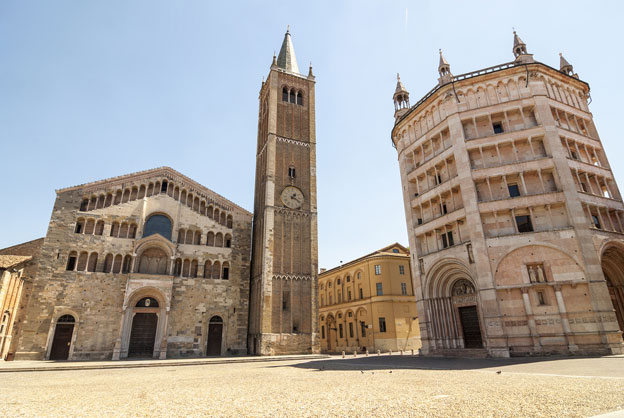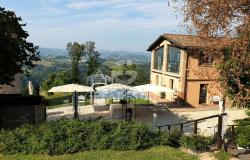The elegant city of Parma, in Emilia-Romagna, is one of Italy’s most prosperous cities and has one of the world’s oldest universities. It is known as ‘the capital of good food’: it has many outstanding restaurants and is famous for its parmigiano (Parmesan) cheese and prosciutto (Parma) ham, still made in the area using centuries-old techniques. The city’s fascinating, cobbled, medieval streets and squares are adorned with grand buildings, many housing important museums and theatres.
Il Duomo
The 11th-century Romanesque Duomo (Cathedral), overlooking the Piazza del Duomo, has three tiers of loggias and three portals. Antonio da Correggio’s fresco depicting the Assumption, on the octagonal central cupola, is regarded as a masterpiece. The crypt contains fragments of mosaics which show that a temple was on this site at least as far back as the 3rd or 4th century AD. The brick-built campanile was added in the late 13th century.
Il Battistero
The 13th-century, pink marble Battistero (Baptistry) is octagonal on the outside and sixteen-sided on the inside. The outside is asymmetrical as, at the time it was built, symmetry was regarded as a symbol of death. It has a beautiful, domed ceiling and contains early-13th-century sculptures by Benedetto Antelami, depicting months, zodiac signs and seasons. There are elaborate frescoes within each of the 16 arches.

Cattedrale di Parma and Battistero
Palazzo del Vescovado
Also on the Piazza del Duomo is the imposing Palazzo del Vescovado (Bishop’s Palace). It was built in the 11th century on a site that had been occupied since the 6th century. It has been rebuilt and renovated several times although it still has the city’s oldest wall, in an alleyway. The façade is early-20th-century. Recent restoration works have revealed medieval features in the tower and over the entrance.
Palazzo della Pilotta
The huge, 16th-century Palazzo della Pilotta was built to house court and state services including stables, hay store, arms room, barracks and theatre. It was rebuilt after being largely destroyed during World War II and now contains several museums and institutions. The 17th-century Teatro Farnese, built in the former arms room, is regarded as one of the most beautiful historic theatres in Italy. It is constructed from wood, plaster, straw and fabric. It features a wooden enclosure to allow for the staging of battles at sea, and has Italy’s first revolving stage. The Galleria Nazionale contains important paintings from the 13th to 19th centuries. The Museo Archeologico Nazionale has finds from the ancient Greek, Etruscan, Roman and Egyptian civilisations. The palazzo also houses the Academy of Fine Arts, the Bodoni Museum and the Palatina Library.
Palazzo Ducale
The 16th-century Palazzo Ducale, with its distinctive yellow façade incorporating 18th-century statues, is at the entrance to the Parco Ducale. In the 16th century it became the home of the Farnese family and now houses the offices of the Carabinieri, although guided tours are available. It contains 16th-, 17th- and 18th-century frescoes and a monumental staircase. The Sala degli Uccelli has a spectacular vaulted ceiling painted with 224 birds of different species by Benigno Bossi. It was rebuilt after being partially destroyed during World War II.

Palazzo Ducale
Palazzetto Eucherio San Vitale
Also in the Parco Ducale is the 16th-century Palazzetto Eucherio San Vitale, which was built before the garden existed. Recent restoration works have uncovered fragments of 16th-century frescoes.
Palazzo Sanvitale
The Palazzo Sanvitale, on Strada Benedetto Cairoli, was the residence of the Sanvitale family. It is the headquarters of Banca Monte Parma and Monte di Parma Foundation and is a venue for conferences and exhibitions. Since 1999 it has also housed the Museo Amedeo Bocchi.
Piazza Garibaldi
Piazza Garibaldi, in the heart of the city, is the site of a former Roman forum. It is regarded as the most beautiful piazza in Parma and features statues of the Italian unifier Garibaldi and the artist Correggio.
Palazzo del Governatore
On Piazza Garibaldi is the Palazzo del Governatore, which was originally two 13th-century buildings. The Baroque tower was built in 1763 and contains the bell from the original tower, which collapsed in 1606. Two fascinating sundials were added to the façade in 1829. The palace is a venue for modern art exhibitions, workshops and meetings.

Elegant buildings in Parma
Palazzo del Comune
Also on Piazza Garibaldi is the 17th-century Palazzo del Comune (City Hall), which has a frescoed façade. The Sala Consiliari (Advisory Room) contains 19th-century frescoes.
Ospedale Vecchio
The Ospedale Vecchio (Old Hospital), with its long, arcaded façade, was created in 1250 and now houses the State Archives, the Municipal Historical Archives, the Civic Library, the Bizzozzero Library, the Oratory of Sant’Ilaro and the Lino Ventura Film Centre.
Teatro Regio
The world-renowned opera house, Teatro Regio, opened in 1829. It has a Neo-Classical façade and the auditorium contains gilded tiered boxes; a chandelier manufactured in Paris weighs one ton.
La Casa di Toscanini
Casa di Toscanini, the birthplace of the great conductor, Arturo Toscanini, contains his batons, theatre programmes and personal effects.







